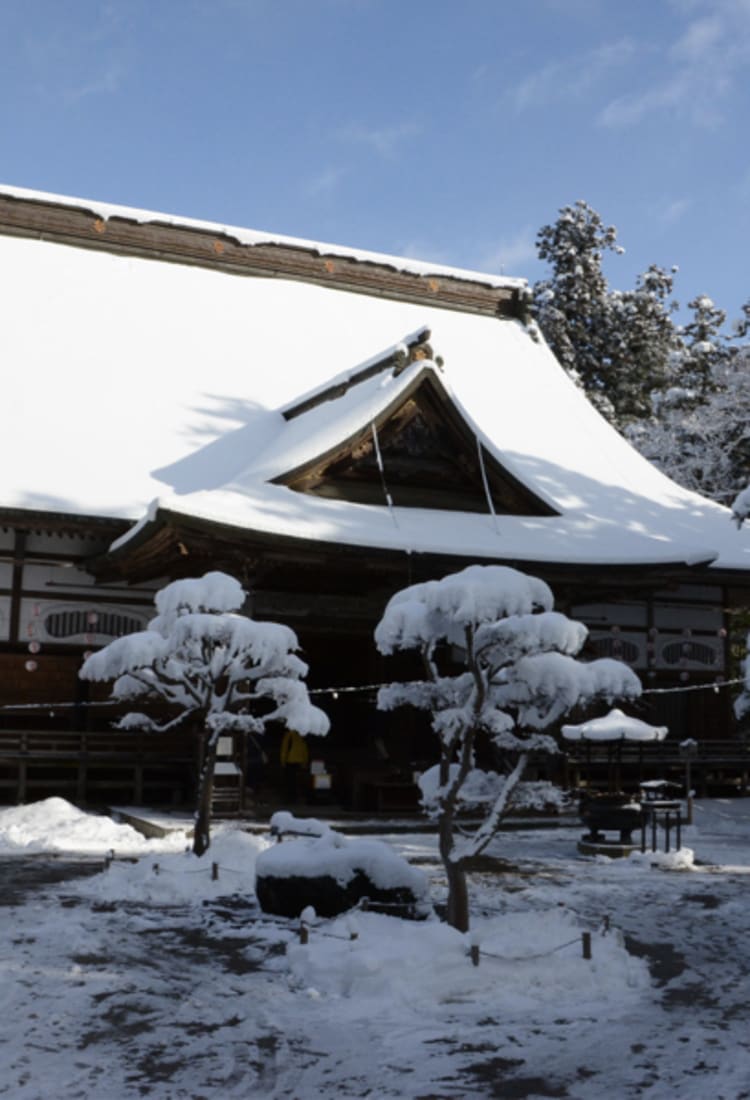
Your tour of the World Heritage site of Hiraizumi starts with a National Treasure in glimmering gold
Your tour of the World Heritage site of Hiraizumi starts with a National Treasure in glimmering gold
Buddhist art more than 800 years old still captivates at the Konjikido at Chuson-ji Temple (National Treasure)
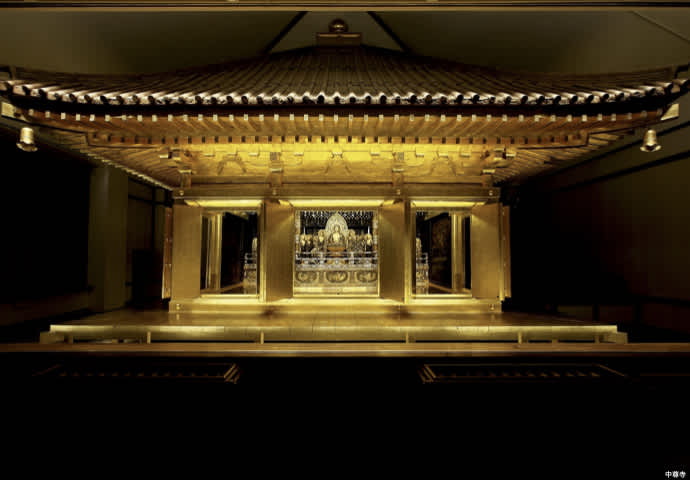
Of all the elements that make up the Hiraizumi World Heritage Site, Chuson-ji is absolutely not to be missed. Constructed in 1124, this precious temple remains largely in its original form, save for a portion that was destroyed by fire in the 14th century. Within Chuson-ji is the Konjikido, or Golden Hall. As its name suggests, the interior walls, exterior walls, and ceiling are entirely covered in gold leaf, giving the entire structure a golden gleam.
Opulent radenzaiku1 mother-of-pearl inlays and makie2 gold lacquer flourishes are everywhere, including the dais on which the eleven Buddha statues enshrined in the inner sanctum sit and the flower patterns on the pillars that surround them. These decorative touches create a magnificently luxurious effect.
The Konjikido was constructed by Fujiwara no Kiyohira, a man who won numerous battles in this area in the middle and late 11th century. He was also a devout Buddhist, and set out to create a Buddhist utopia in Hiraizumi—spending more than twenty years on the Konjikido and other structures in the area.
The Sankozo Museum is another a must-see at Chuson-ji. The priceless items in the treasure house speak to the spectacular achievements of four generations of Fujiwaras following Kiyohira. It is filled with precious cultural properties on display, including Buddha statues, the burial accessories kept in the coffins enshrined below the Buddhist dais in the Konjikido, and more.
The look of the path leading up to the temple, known as the Tsukimizaka (Moon-viewing Slope), changes markedly with the seasons. The vibrant leaves in autumn and the snow-covered views in winter are particularly beautiful here.
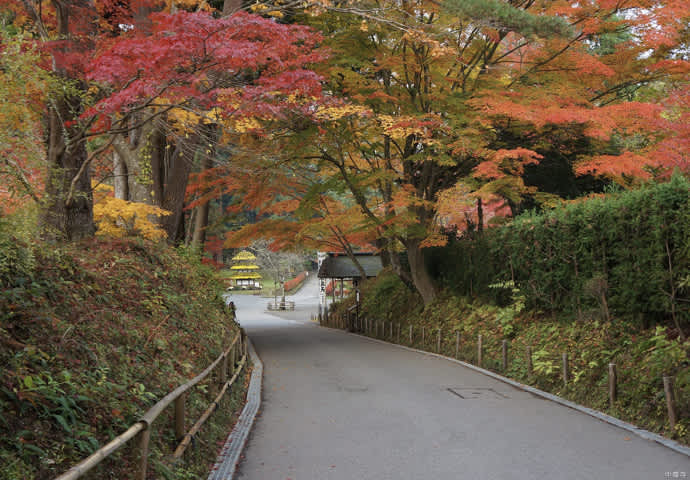
Between the Konjikido and the Sankozo lies a narrow pathway that leads down to a lake. In summer (between mid-July and mid-August), it is lined with pink flowers known as Chuson-ji lotuses. They come from seeds nearly 800 years old that were found in archaeological excavations, which were then germinated and propagated after tireless research. These gorgeous blooms are said to be the same flowers that adorn the Pure Land, and are sure to bring peace to your heart.
1 Radenzaiku is a decorative technique that uses mother-of-pearl (thin slivers of pearl shells) and inlaying them on a lacquered or other coated surface to create a design.
2 Makie is a decorative technique that sticks gold, silver, or other colored powders on top of lacquer to create pictures and designs.
The temples and gardens of Hiraizumi offer a glimpse of the ideal Buddhist world
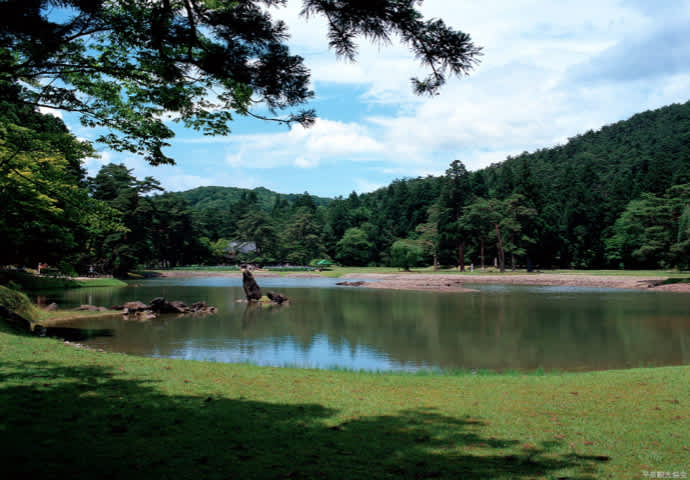
The other temples and gardens that make up the Hiraizumi World Heritage sites are scattered in the area around Chuson-ji. If you start your journey at Hiraizumi Station, you can take the circular bus (guidance available in English) or a taxi from there to get around. Some of the temples are also within walking distance from the station.
About 1.7 kilometers from Chuson-ji is a temple called Motsu-ji that has a beautiful park with the Oizumi-ga-ike pond at its center.
Tiny streams flow through the garden into the lake, which has groups of large, interestingly-shaped rocks protruding from the surface and along its shore, creating a wavelike coastline that looks like an ocean beach. The park that contains these elements is said to faithfully represent the ideas and techniques presented in the Sakuteiki, a late 11th-century treatise on garden-making and Japan’s oldest manual on the subject. The garden is made to recreate the look of natural mountain and ocean vistas, and is celebrated for showcasing the best features of a variety of picturesque spots while infusing them with a unique sense of design. The universal beauty of the Motsu-ji garden maintains its impact even amidst our modern garden landscaping techniques.
Motsu-ji garden was intended to recreate the Pure Land here on earth. Among the many picturesque spots in Japan, it has been nationally designated as a Special Place of Scenic Beauty.
The main hall at Motsu-ji Temple is a reproduction, but the site contains enough original cornerstones, earthen walls, and numerous other archaeological remains to be nationally designated as a Special Historic Site. The combination of the garden and historical ruins allow you to experience two nationally-acclaimed treasures in one location.
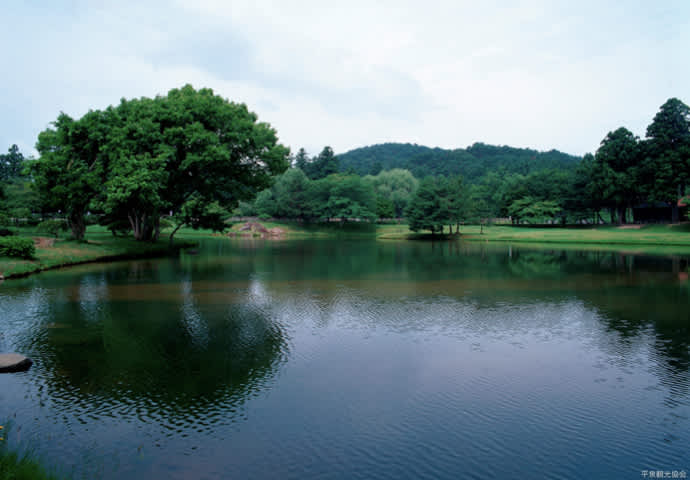
Just to the east of Motsu-ji is another Pure Land garden known as Kanjizaio-in, which is preserved in a nearly perfect state. Built around Maizuru-ga-ike pond, it is also a beautiful example of Pure Land ideals—complete with rock arrangements and streams of water made to look like full-size waterfalls.
Like the garden at Motsu-ji, Kanjizaio-in faithfully adopts the techniques prescribed in the Sakuteiki. Comparing and contrasting the two in terms of their unique features and common elements is a fascinating exercise.
Mochi is the signature dish of Hiraizumi, and the town also offers relaxing hot springs
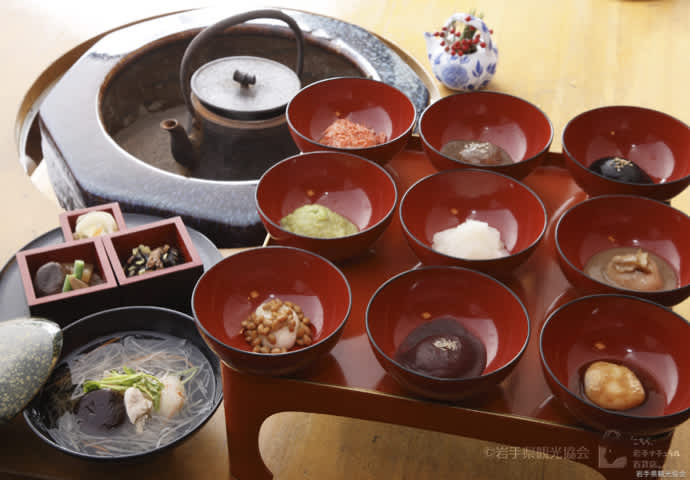
No trip to Hiraizumi would be complete without sampling the delicious local mochi dishes. Along with the neighboring city of Ichinoseki, the town has carried on its ancient and unique mochi traditions. In fact, there are nearly three hundred types of mochi preparations available in the region.
These mochi dishes can be enjoyed as snacks with adzuki beans, edamame, or broad bean paste, or as part of a meal that includes shrimp, leeks, shiitake, and other local delights. There’s simply no end to the mochi variety here. Restaurants in town have a variety of mochi offerings, so make sure to sample as many as you can while you’re here.
Nothing beats a soothing soak in a hot spring after a day spent walking around the World Heritage temples and gardens. Luckily, the entire Hiraizumi area is in a hot spring zone and dotted with facilities that welcome day visitors as well.
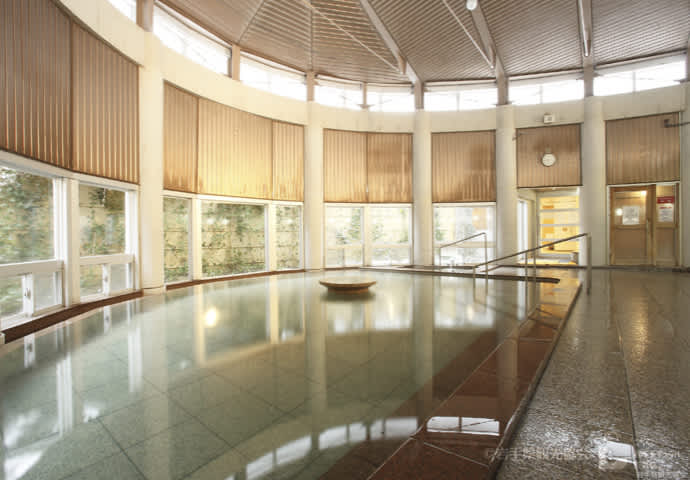
If you visit Hiraizumi in winter, you’ll crave the warmth of its hot springs even more. Spend some time relaxing your body and mind as you sear the gorgeous memories of the area’s snow-covered temples and gardens in your mind.
Contact information
Hiraizumi Tourism Association
Choson-ji Temple




















































